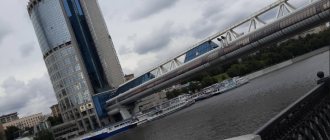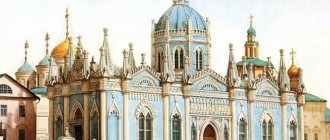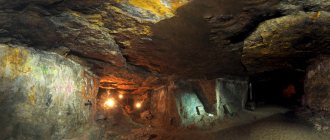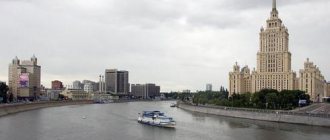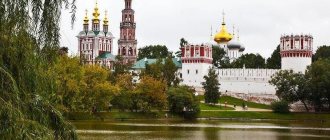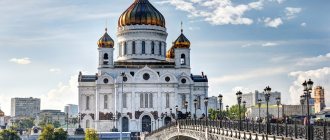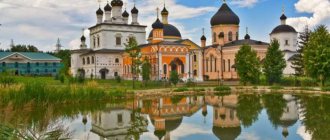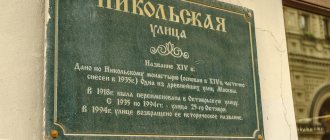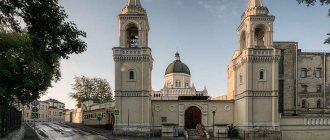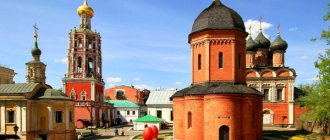How to get there
The monastery was erected in Moscow, on the street. Shosseynaya 82 in the isolated area of Pechatniki. Its terrain is limited on all sides by a railway, river or industrial zone. Most of the territory is occupied by various enterprises. The stop with the same name is located in the south-eastern Moscow district. You can get here from almost anywhere in the city by bus No. 161, 292, 30, 438, 524, 703, 736.
When traveling by metro, you must first get to the “Pechatniki” or “Textilshchiki” stop, and from there take a bus to the monastery gates. From the railway platform (Depo stop) you can walk to the monastery in 15 minutes.
How to get to the Nikolo-Perervinsky Monastery
You can get to this monastery either by your own vehicle or by public transport. In the latter case, there are three options:
- get to the Tekstilshchiki metro station, and then transfer to bus No. 703 or 161;
- take minibus No. 38M;
- get to the Pechatniki metro station, and then take buses No. 161, 292, 703.
You should get off buses and minibuses at the Nikolo-Perervinsky Monastery stop.
Historical data
The Nikolo-Perervinsky Monastery is located on a hill. Previously, wide open spaces opened up from here and 40 of the capital’s churches could be seen. History connects the founding date of the monastery with the Battle of Kulikovo. The original mention of the monastery dates back to 1567, where it was referred to as “Nicholas the Old”.
An interesting legend is associated with the modern name: once upon a time the flow of the capital’s river passed almost at the walls of the monastery, which caused inconvenience to the spiritual brothers, and then the river made a large turn 10 m from the monastery fence and flowed towards Kolomenskoye.
There is also an assumption that during the Time of Troubles the monastery was attacked and plundered by the Poles. At that time, Tsar M. Fedorovich was engaged in the restoration of the monastery, and under his son the monastery experienced an era of prosperity. Donations from the government, parishioners and clergy made a great contribution to its development.
According to another theory, the name of the Perervinsky monastery was given to it only in the 15th century. in honor of the location, which is associated with the fact that the bed of the capital river in this part of the suburb was interrupted and was no longer flowing. According to this version, according to documents, the monastic history begins to be traced from 1623.
In 1929, the Moscow chapel of the monastery was completely destroyed, like the one located in Vykhino. 2 more chapels - Kaluga and Serpukhov in the 19th century. gave the monastery to the Ferapont Luzhetsky monastery, but they also did not reach the present day.
For three centuries, the history of the monastery has been connected with the life of Russian church leaders there:
- XVII century – visit to the monastery by the last 10th Patriarch of Moscow and All Rus' Adrian. He was an opponent of Western customs, was distinguished by a conservative worldview, revered Russian antiquity and beliefs, and regularly performed divine services. He denied the views of Peter I and because of this he moved to the Perervinsky monastery, where he later died of paralysis.
- 1700 g. - under the leadership of Adrian, the temple of St. was built and consecrated. Nicholas. The architecture of the church was distinguished by the Moscow Baroque style. The construction of the building was carried out with the capital of the reverend.
- 1733-35 gg. – on the site of the monastery a temple of the Tolga Icon of the Mother of God was erected.
- The end of the 18th - beginning of the 19th centuries. famous for the influence of Platon Levshin. This is a metropolitan and preacher, Paul’s educator. He made a huge contribution to the development of the monastery and raised more than one generation of shepherds. Under his leadership, a two-story metropolitan house was built.
- 1775 g. – P. Levshin organized the Pererva Seminary. He cared for her and her pupils in a fatherly way. In the same year, a refectory was installed.
- 1787 g. - on the instructions of Metropolitan Platon, the Assumption Church was restored. Its decoration is dominated by gold and silver. The capacity of the cathedral was small, so services were held only on patronal feasts.
- 1812 g. – the church was occupied by the French, but all items of value were transported on time or safely hidden.
- 1821 - after bishops Augustine and Seraphim, the department was headed by Philaret. The monk, wanting to give the monastery greatness and beauty, contributed to changes in the internal space and external walls of the monastery. The 2nd floor was completed in the school building, additional buildings were erected and existing ones were reconstructed.
- XIX century – the architectural ensemble was supplemented with cell buildings and a stone fence.
- End of the 19th century - construction of a house church, which bore the name of the righteous Nicodemus.
- 1904 city - Metropolitan Vladimir visited the complex. The Iveron Icon of the Mother of God was brought to the monastery, in whose honor the clergy decided to build a temple on the territory.
- 1906 g. - 2 schools began to function: 1st - spiritual and 2nd - for deaf and dumb people from birth.
- 20s XX century – are considered the date of closure of the monastery. However, services were held in the old cathedral almost before the start of the war.
- 1921 g. - Patriarch Tikhon visited the monastery and provided him with prayer support.
- Mid-XX century – Iveron Cathedral was deprived of crosses, domes and church decorations.
- 60s XX century – ceilings between floors were installed, and the painting was painted over. After this, the monastery complex was transferred to a metal and plastic toy factory, and later metal cutting machines were produced there.
- 90s _ XX century – the remains of the monastery were given over to the church.
Architectural and restoration changes to the monastery are marked by the following dates:
| date | Description |
| 70s XX century | Restoration has begun. |
| 80s XX century | A new gilded cross shone on the cathedral. |
| March 1991 | This is a special date that has gone down in history: services were restored in the old cathedral. |
| 1998 | The cathedral was consecrated by Patriarch Alexy. |
| 2000 | In St. Nicholas Cathedral, the wall paintings were restored and a new iconostasis was created. |
| 2008 | Appearance of a monument to Metropolitan Platon. The work on its construction was carried out by the sculptor Bichyukov. The monument looks majestic and corresponds to the splendid atmosphere of the monastery. |
Underground passage
The Nikolo-Perervinsky Monastery has interesting legends about the dungeon that connects the 2 banks of the capital river. They talk about a secret passage that led from the Kolomna Church of the Kazan Mother of God and was dug to give the king and his relatives the opportunity to hide in the event of riots.
Indigenous residents told about the dungeon to the historian I. Ya. Stelletsky, who discovered in the second 10th anniversary of the last century 2 corridors leading from the altar of the Kazan Church to the basement. After another 10 years, research was stopped at the request of the Kolomenskoye architect: he believed that excavations threatened to destroy the building.
Years of total atheism
After the October Revolution, the Nikolo-Perervinsky Monastery in Pechatniki - as it is often called by the current name of the area where it is located - shared the bitter fate of thousands of Russian holy monasteries. Throughout the twenties, there was a process of its gradual abolition and transfer of premises for use for various economic purposes. The schedule of services in the Nikolo-Perervinsky Monastery disappeared for a long time from the gates of the monastery, giving way to government signs with the names of the state institutions located in it.
A very sad fate befell the Iveron Chapel. She was repeatedly robbed by both criminals and representatives of the new government. From the icon, which was revered by all of Russia, the bandits stole the crown, trim and precious stones. They failed to tear the golden robe from her, but the security officers who came after them successfully coped with this.
In 1924, many members of the community were repressed, and for five years the chapel was at the disposal of the Renovationists - a movement of clergy who broke away from official Orthodoxy, trying to change the church charter and enter into cooperation with the Bolsheviks. Finally, in 1929, by decision of the Moscow City Council, it was destroyed.
Architectural features
The central place of the monastery is the St. Nicholas Church. Before its creation, there were 3 stone churches on the site, erected at the end of the 18th century, which Patriarch Adrian united into part of the large St. Nicholas Cathedral. Its construction took about 4 years.
The work was carried out as follows:
- the central building was connected to the cells of the patriarch. This made it easier for the aged Adrian to come to church;
- in the northwestern part there was a room where Adrian could hear worship through the window;
- the walls of the upper part of the temple were painted. They reflected events from the Bible. The altar was decorated with biblical images, and on the dome there was a plot of the Ascension of the Lord. The figures were updated periodically;
- in the lower part there was a church in honor of S. Radonezh. Conventionally, it could be divided into 3 architectural zones - the altar room, the refectory and the central hall;
- in 1750, a stone building was erected in the southern part of the complex, where the abbot lived on the top floor and the spiritual brothers on the lower floors. After 17 years, the building was merged with the patriarchal chambers.
The bell tower is located close to the temple from the southeast. The height of it and the temple are almost the same. There are bells at the top, and the top is decorated with a gilded cross. In 1767, the 3rd floor was painted using silver hallmarks. According to the documentation of the 80s. XIX century in the eastern part of the monastery there was a cemetery, and in other parts of the world there was a front garden.
In the south, fruit trees were planted, in the shade of which there was a gazebo, vegetable crops grew, there was a pond, a beekeeper and a 2-story bathhouse. On the eastern side of the old cathedral rises the Iversky Church, which was built at the beginning of the 20th century. under the leadership of architect Vinogradov. Inside was placed the image of the Iveron Mother of God. Up to 3,000 people can stay in the building at the same time.
The church has 16 blue domes, which are visible from the surrounding area and the Pererva station. Above the gate that leads to the monastery, there is a temple, which was dedicated to the Tolga Icon of the Mother of God. It was built in 1733. Since 1924, the gate church became a place for the club and canteen of the orphanage, and then was converted into housing: the frescoes were whitewashed.
The church underwent the biggest changes after the war - then a building for a factory was added on the side of the altar.
In 2014, a wooden Church of St. John the Evangelist was erected on the territory between the vegetable garden and the river bank. It hosts monthly services and occasionally beautiful wedding ceremonies. On the eastern part the monastery is fenced, on the other sides the territory is limited by stone buildings of the 2nd centuries. These are the patriarch's cells, the bishop's cell, the abbot's cell, as well as the old and new corps of seminarians.
Shrines
The Nikolo-Perervinsky Monastery, which has ancient icons, is visited by believers for prayers. The images of the Mother of God - “Iverskaya”, “Bogolyubskaya”, “Sovereign” - are used for worship. Before the revolution, the monastery had its own Iveron Chapel, built in 1666. Services were held there twice a year, dedicated to significant dates associated with the Iveron Icon.
Nikolo-Perervinsky Monastery, icon of the Iveron Mother of God.
The relic was placed in a niche intended only for it, and the robe on it was incredibly rich - made of pure gold, pearls and shining expensive stones. From the very beginning, the chasuble was simpler: it framed the icon until 1790, when the merchant Tverdyshev, blessed by High Hierarch Plato, made the frame rich. In the place for the icon in the niche there is a rich chandelier.
She herself stands there only on holidays, because this is the main shrine of the capital - it is used for home prayers, which are ordered by Orthodox Christians. At that time, the monastery chapel mainly housed a copy of the original icon. In addition to it, 2 more icons (the Savior and St. Nicholas the Wonderworker) were held in special esteem by the parishioners.
Iveron Chapel
During the same reign, but two decades later, the stone temple of Sergius of Radonezh appeared, and in Moscow itself, by the highest decree, the chapel in the area of the Neglinsky Gate (later the Resurrection Gate), then widely known as the Iverskaya, was assigned to the monastery. It received its name as a result of the fact that since 1669 it kept a copy of the Iveron Icon of the Mother of God brought from Athos, to which all of Moscow gathered on holidays. In this regard, the Nikolo-Perervinsky Monastery received even greater fame, and therefore an influx of pilgrims.
Territory of the complex
In addition to the temple, the Nikolo-Perervinsky Monastery currently has:
- children's Sunday school;
- economic developments;
- monks' cells.
The area is richly landscaped.
The second church of the monastery is the Assumption Church, built of stone, which has 5 tiers:
| Tier | Description |
| 1st | This is where the main entrance is made |
| 2nd | Is the monastery sacristy |
| 3rd | This is a church dedicated to the Dormition of the Mother of God |
| 4th | The clock that struck |
| 5th | Belfry with bells |
Today the territory of the monastic residence includes:
- 2 cathedrals (new and old);
- Church of the Assumption of the Blessed Virgin Mary;
- Church of the Tolga Icon of the Mother of God;
- 2 buildings for seminarians of the 17th and 18th centuries;
- bishop's corps;
- the patriarch's cells dating back to the 18th century.
On the territory of the monastery there are also the building of the seminary and abbot, a monument to Metropolitan Plato. Visitors are greeted by the northern and eastern gates. The territory is surrounded by a fence with towers.
Under the patronage of the first Romanov tsars
The reign of the first of the Romanovs, Tsar Mikhail Fedorovich, became a period of active growth and expansion of the Nikolo-Perervinsky monastery. Records have been preserved of the generous contributions made by him, as well as by clergy and secular persons who donated to the monastery both sums of money and liturgical books and all kinds of church utensils.
Active construction in the monastery began with the accession to the throne of his son, the next sovereign, Alexei Mikhailovich Tishaishago. Thanks to his patronage and financial assistance, in 1649 two stone churches were laid at once - in honor of the Dormition of the Mother of God, which was consecrated a year later, and St. Nicholas the Wonderworker - a larger building, completed and consecrated in 1654.
Operating mode
At the moment, services are held only in St. Nicholas Cathedral, open from 7:00 to 17:00. Parishioners can order services here, get married and be baptized.
The schedule is as follows:
- at 7:30 – Divine Liturgy takes place;
- at 16:00 – the akathist is read, after which the evening service takes place;
- On Sundays and holidays there are 3 liturgies: at 6:30 and 9:00 for everyone, and at 8:00 for children.
Parishioners get married only on odd days of the week, starting from Sunday. Exceptions are Mondays, days before major holidays and major fasts. The wedding necessarily involves an appointment in the icon shop and a conversation with the priest, which is called preliminary and takes place only on Mondays at 20:00.
They baptize only on weekends. Before this, it is mandatory to come to 2 public conversations: if this is an adult, then the person being baptized also comes to the conversation, if it is a baby, then it concerns only future recipients - godfather and mother. The priest talks with them from half past eight in the evening every Friday directly in the baptismal center, which is located at the temple.
There are no breaks in the work of the icon shop at the monastery: you can purchase church goods from 7:30 to 19:00. Sunday school starts immediately after the service for children.
Schedule of services at the Nikolo-Perervinsky Monastery
| Day of the week | Divine service | Start time |
| Monday-Saturday | Liturgy Akathist Vespers, Matins | 7.30 16.00 17.00 |
| Sunday | Liturgy Liturgy for children Akathist Vespers, Matins | 6.30, 9.00 8.00 16.00 17.00 |
Please note that on holidays, as well as during fasting at the Nikolo-Perervinsky Monastery in Pechatniki, changes in the schedule of services . There is a Sunday school at the monastery; In churches you can order services, the sacrament of baptism or wedding.
Excursion programs
The Nikolo-Perervinsky Monastery is currently one of those visited least by pilgrims and tourists, making it one of the quietest in the capital region. As a rule, one-day excursions are organized here. Since the monastery is not currently operating and has the status of a patriarchal metochion, there are no problems with access to the territory; you can come there any day.
If visitors travel for the purpose of pilgrimage, it is better to do so on the days of temple services. For those who want to admire the local architectural beauty, there are no such restrictions. Here you can look at the original ensemble of buildings, which are gradually being restored and updated. Thanks to constant work, the monastery courtyard always looks lively.
The ban on taking photographs and videos is strict here; this must be remembered and respected. If necessary, you should first ask the abbot for a blessing for filming and if he refuses, do not persist.
The territory of the monastery is a church place, women cannot enter here without a headdress and men in it, beachwear is strictly prohibited for persons of both sexes, women should not be too open, men should not enter in a tracksuit.
The behavior of monastery guests should also be appropriate:
- there is no smoking or drinking inside;
- do not pass through the gates of the monastery drunk;
- Swear words, as well as loud speech and music are strictly prohibited;
- if guests remain for the service, it is not allowed to talk with neighbors - only reverent silence.
The historical Nikolo-Perervinsky Monastery was abandoned for a long time, so restoration work has been ongoing for a long time. Many pilgrims come every year to see how this place is being restored and rebuilt. Now its territory is 4 times larger than the area of the Sretensky Monastery, but 5 times smaller than that of the Novodevichy Monastery.
